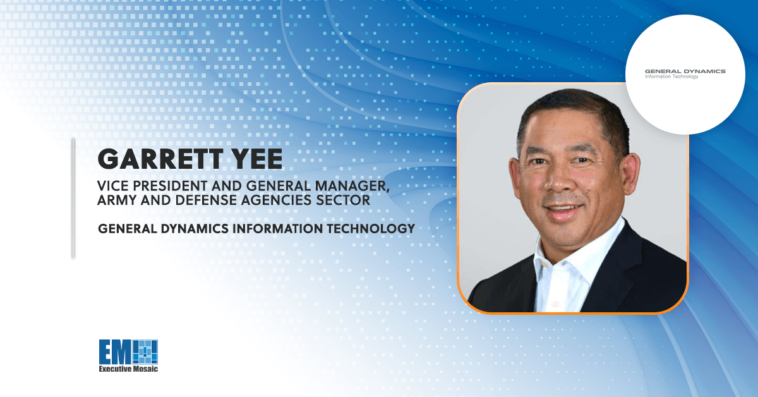Prior to joining General Dynamics Information Technology in August 2022, Garrett Yee served as a Major General in the U.S. Army, finishing his military career at the Defense Information Systems Agency. Now, he serves as vice president and general manager of the company’s Army and Defense Agencies sector, where he oversees more than 3,000 employees worldwide.
Guided by lessons learned during his extensive military career, Yee is dedicated to building a positive, mission-focused environment for GDIT’s workforce. In doing so, he has made it a top priority to cultivate a collaborative space where government needs and industry offerings are intertwined.
Yee recently detailed these efforts in an Executive Spotlight interview, during which he sat down with ExecutiveBiz to discuss talent development and retention, GDIT’s company culture and the intersection between the public and private sectors in supporting the Department of Defense mission.
Tell me about your company’s culture. What aspects of the company do you think are contributing most to its success while helping to attract and retain top-level talent?
GDIT has 28,000 employees – we are a large company. We have a saying here that GDIT is a “company with a soul.” That statement comes from our president, Amy Gilliland, who truly believes in doing the right thing for our employees and the mission at the same time. It’s not enough to just have a job – you need opportunities to have a fulfilling career. When you have goals and aspirations and you come to a company like GDIT, we will try to help you achieve them.
We want to retain talent – we are in the people business. Every year, we make investments to support our employees’ professional growth, long-term careers and well-being. For example, a couple of months ago we launched a multipronged investment in cutting-edge technology solutions, talent development and employee growth programs. It is not just the tangible things we offer, it is our attitude toward our employees. We do our very best to let our employees know that we value their contribution.
What advice would you give to those transitioning from the government into private industry?
First off, you have to be open-minded. I often talk to transitioning senior leaders who may be looking for an equivalent level of responsibility in the private sector. There’s nothing wrong with that, but oftentimes, those kinds of jobs may not exist. I will say that it is also important to try and find a job where you will learn and grow. When I first started the transition process, I had no idea that I would be running a very large profit and loss center, but that’s where I landed, and it has been a great fit for me.
I would also tell transitioning senior leaders to temper their expectations. There tends to be a lot of talk about “what I’m worth” in terms of salary. I get it. But it is more important to find something that you will enjoy doing than finding a great paying job that isn’t a fit for you.
One of the things that we do very well in the government is planning one or two jobs ahead. We’re always planning ahead, so when you transition to your next job, you will be as ready as you can be. We are also very good at building our military and government network – we had to in order to be successful.
So, when it comes to planning for transition from the government to the private sector, it is not any different. We need to plan for the next job after government service, well in advance. Waiting until the final 6-12 months is probably not sufficient. There is a common saying, “Failing to plan is planning to fail.”
The other thing that we need to do is build your industry network. This takes a lot of time. It needs to go beyond casual meet and greets. Like in any relationship, you need to invest. It’s not who you know, it’s who knows you.
Your career includes time in both the public and private sectors. Can you speak about the challenges and rewards of reacclimating between government and industry?
I am just as proud of what I do in this role as I was when I was serving in uniform. On the government side, your job is often to define the requirements. It is the role of the systems integrator, like GDIT, to do the work. We take pride in knowing that what we do saves lives and makes our warfighters more lethal.
In the military, we have a lot of camaraderie, which is wonderful. That said, I have also found camaraderie with my private sector teammates. The folks that I get to work with here at GDIT are dedicated to the mission, hardworking, and fun to be around.
Communications here at GDIT are very flat, so my communication up and down the chain is not encumbered by hierarchical barriers. If our president wants to reach out to me, she’ll send me a note directly. We communicate laterally and vertically, which is more practical and optimizes how we do our work. In my current job, I have more than 3,000 employees in 20 countries around the world. If I relied on strict, hierarchical ways of communicating, I would not be supporting the warfighter optimally.
What’s the biggest lesson you’ve learned during your time in government, and what advice would you give to those considering entering or transitioning to a career in public service?
One thing I learned when I was on the government side is how important it is to get to know your industry partners. I was fortunate that my job required me to engage with industry. Many of my colleagues in the government were reluctant to talk with industry. What I found surprising is that oftentimes, the contract workforce is bigger than the government workforce. As a senior leader, why would you not want to know the leaders you’re working with? If 40 percent of your workforce is government and 60 percent are contract workers, you might be missing something if you don’t talk with the leadership of the 60 percent. By getting to know your industry partners and their leadership, you’ll discover things that will benefit your organization and learn how to better leverage capabilities, optimize processes and more.
For those that are considering going into public service, I say, please do. If you do spend a little time in public service, the skills that you bring from industry will lead to a better Defense Department and a better government. If we want to have the best military, the best schools, the best communities, then we need our best and brightest also going into public service, not just the private sector. Whether you’re coming out of college or have already spent time in industry, please consider public service even if you’re a little interested.
What is your strategy for attracting and retaining top-level talent in the midst of ongoing talent shortages in today’s highly competitive market?
At GDIT, it’s being both mission-focused and employee-focused; it’s ensuring that we have meaningful missions and jobs for our workforce; it’s pushing forward with innovative technologies to make our military better; and it’s making sure our employees know that we care about them. Back to the statement from our president, GDIT is a “company with a soul”; I think that resonates with a lot of people.




